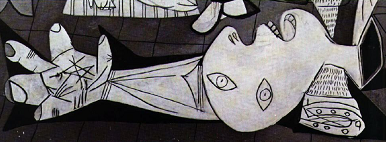Spadina Literary Review — edition 31 page 05
fiction

Pablo Picasso, Guernica (detail)
Guernica
by Richard Rose
Although Simon had known this image from afar, having pored for many hours over reproductions in several of the books in his study at home in England, he had not been fully prepared for the emotion he now felt when standing a few feet from the real painting. It is not only the overwhelming size of the picture that can never be truly conveyed in a photograph, he decided, but also the rawness of the emotion captured in the stark representation of annihilation and death. Now he began to understand the power of those dark tones. He could see how the decision to go with tones of black and white was the only possible one Picasso could have made when he sought to convey the full horror of the day. Here, captured like some grotesque scene from mid-20th-century film noir, was the blood and the bone, the agony and the stench of fear that wrenched the life from a small Basque town on a late afternoon in 1937. Hieronymus Bosch depicted horror in his paintings of The Harrowing of Hell and Death and the Miser, but in his works we see fiction, whilst Picasso reports the stench of real death and destruction.
Guernica. The very word has come to signify atrocity. See the wailing women in their death throes, the mother clutching her child as it exhales one final breath. See the splintered bone and torn flesh, and those wide harrowing eyes everywhere, staring in desperation from across the canvas. And central to the maelstrom, the screaming horse, strength reduced to nothing as it falls, whilst the very symbol of Basque manhood, the mighty bull — hero of the encierro, the running of the bulls — leers startled and disjointed amidst the chaos of the aftermath of the air attack.
Simon stood transfixed for a full fifteen minutes, his eyes unable to assimilate all he needed to see and understand. It is not only the sheer size of the picture that demands attention, but also the magnitude of the situation conveyed through the anger of the artist. This, he already knew, is a painting which cannot simply be skimmed or quickly passed over. Just as the gaze has contemplated one part of the story, so the eyes are drawn to ever greater detail as it shouts from the canvas. For many years he had wanted to stand exactly where he found himself at this moment. When finally the opportunity had come to visit Madrid, he had eagerly anticipated visits to the Prado and the Museo Thyssen-Bornemisza, but he knew that it was the Museo Nacional Centro de Arte Reina Sofía which would be the vital focus of his pilgrimage. It was only now as he stood so close to Picasso’s Guernica that he could live that visceral moment and could confirm that the journey had been worthwhile.
So enwrapped was Simon in his own world, possessed by the picture that dominated the room in which he stood, that he hardly noticed other viewers who came and went. Often they offered little more than a fleeting look at this masterpiece, sufficient to make a tick on their list of must-see pictures whilst visiting Madrid. It was only when eventually he turned to leave that he noted an elderly woman dressed all in black and hunched forward propped on a walking stick, whose intensity of gaze upon the picture was equal to that which had been his own. Silently, and with hardly a motion, she occupied a position at the left end of the great work, directly before the image of the distraught mother nursing her limp dead child. Simon observed the woman only briefly and knowing how the potency of the image had impacted his own thoughts, determined that he should not intrude upon the privacy of her moment. Turning quietly away from the scene, he moved on.